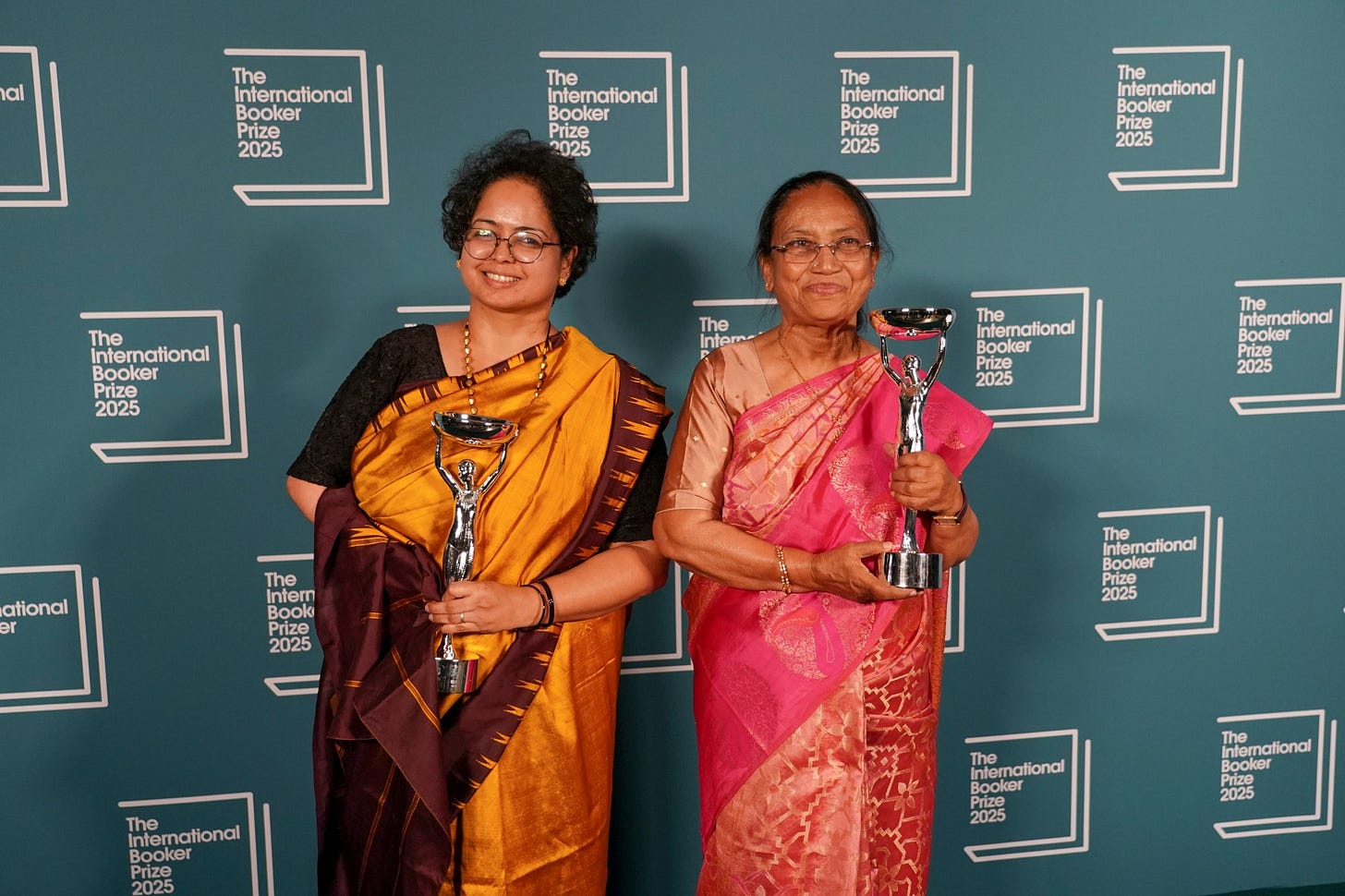On Banu Mushtaq's 'Heart Lamp'
Writing Tip: Learn to write about 'this' world, even as you read about other possible, (hopefully) buildable worlds.

I could write a thousand words about this joyful image of a writer who has remained loyal to her truths, winning one of the most prestigious literary prizes, but for the moment, I will center the book.
The most striking aspect of Banu Mushtaq’s ‘Heart Lamp’ is its non-human landscape. There are plenty of flowers: jasmine dangling, jasmine that masks the smell of rotting flesh, chrysanthemum, dahlias, and roses. Plenty of birds and animals: some appear as metaphors (“croak like a frog”, “as if a rooster”, “crows began to screech in the mutawalli saheb’s mind”). But many are descriptions of the world the characters are embedded in.
I struggle to describe things as they are. In both creative and academic contexts, I find it difficult to portray the world without the aid of metaphor or theory. One of the most valuable pieces of writing advice I’ve received came from a professor who taught a course on postcolonial literature. When I was stuck with a draft, she advised me to move all the ideas, explanations, and sources to the endnotes and keep the front of the page for just raw data.
Vivid literature and good academic writing meet in these rare paragraphs filled with simple, clear descriptions.
Usually, when I read Indian stories translated into English, it feels like I’m witnessing the end of a laboured migration. One recent exception I can recall is Maheshwata Devi’s ‘Truth/Untruth’ translated by Anjum Katyal, which I reviewed for the Chicago Review of Books in 2023. Devi’s book in translation felt very much like an original text. Like I was reading a book by Jhumpa Lahiri or Anita Desai. It did not feel uneasy in English, and yet, now and then, there was a feeling of being locked out of a secret. As if there was a withdrawal of context that would surface only if one knew the local context. This is also how I felt about ‘Heart Lamp’. The stories are told with confidence, and capture the ground texture, but they do not feel like they are in a confrontation with English.
There’s a creation of a shared space, where Mushtaq and Bhasti borrow English for their land, for their world. The English is iterative and soft to the touch of these stories. There’s ‘teapoy’. There’s ‘poor thing’. There’s ‘we came just now’. ‘That is all’.
I know little about Banu Muhstaq’s life or about the Bandaya Sahitya movement that she emerged from, but some years ago, I read a few essays from D.R. Nagaraj’s ‘Flaming Feet’ without registering much about this powerful literary tradition. Bandaya was a progressive literary movement in 1970s Karnataka that challenged caste, inequality, and oppression. Though not limited to Dalit writers, they found a particular strength in it to break free from traditional norms of storytelling. Bandaya means rebellion in Kannada. D.R. Nagaraj, a giant of this movement, describes Bandaya’s goal as being able to use literature as a “mirror or a lamp” to study society. These writers brought social consciousness to the forefront of their stories, but they also believed that literature should not become an instrument. Nagaraj argued that “the best writers commit themselves to a non-literary purpose, but they also know that their work can stand independently of and move beyond the author’s intention.”
At the end of the introduction to ‘Flaming Feet’, the social historian Prithvi Datta Chandra Shobhi asks what the purpose of literature should be. “Should it be in the service of social change and provoke action, as Dalit writers argued, or should it make the reader aware of the world around him and reflective, as Ananthamurthy seemed to suggest?” ‘Heart Lamp’ does both.
Meghna Rao’s review of ‘Heart Lamp’ in Himal Magazine contextualises Mushtaq’s work, locating the book in the terrain of Kannada literature and the politics that make up Mushtaq. If you’re struggling to understand what makes ‘Heart Lamp’ distinct (if not worthy of the International Booker), I recommend reading this essay. Rao notes that Bandaya writers used “everyday words”. The directness of such functional language makes ‘Heart Lamp’ a realistic portrait of a very specific set of Muslim characters that you may not always relate to or even understand, but at the end of these stories you get to know them; and some of them– like Amina from ‘Black Cobras– linger.
To write about reality, you need to use real words. This is a mix of two of George Orwell’s famous writing tips: where you can use a shorter word, never use a long one; and where you can do without jargon, do without it. The most profound stories or academic texts are able to move us because they shift us across time and space, transport us to emotional states using words. Mushtaq’s stories do this not by arguing for these women, but by showing tragic but not uncommon circumstances (abandonment, numerous pregnancies) that the reader will want to expunge from the world. The stories are more than mere examples of political concepts. They feel like real life– it’s likely they are, given Mushtaq’s radical personality.
Most of us, even the most urban and digital of us, are not untouched by nature, by animals, by soil and plants; and stench or smell or sweat. Mushtaq seems to advise: To write meaningfully about abstract things like equality and freedom that we hope are possible in a new world, it is necessary first to write about those little things that make up this world.


